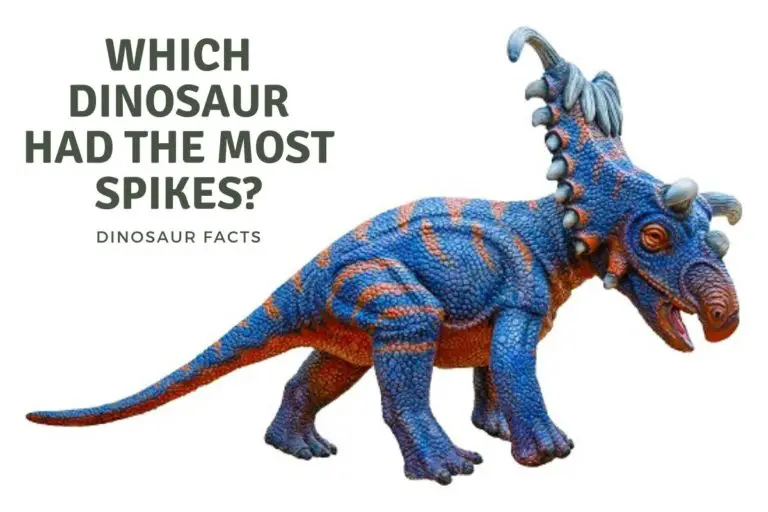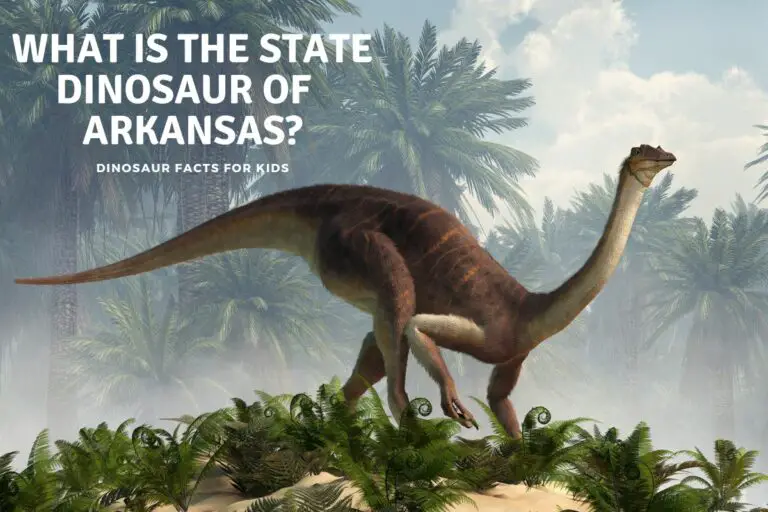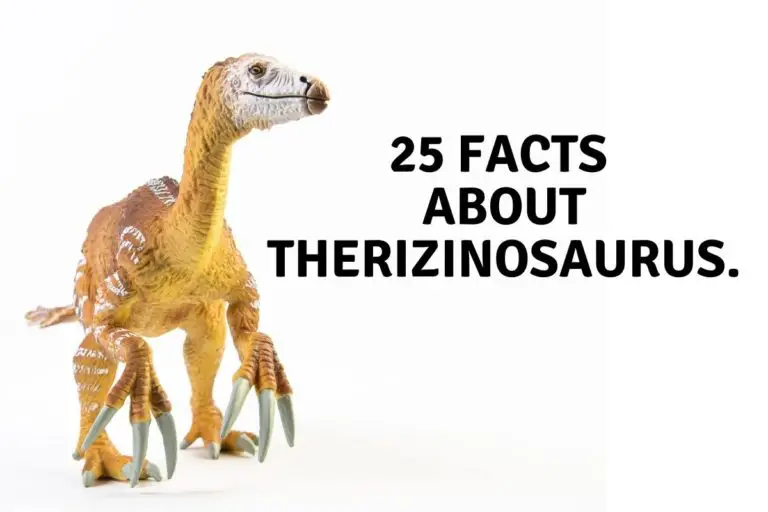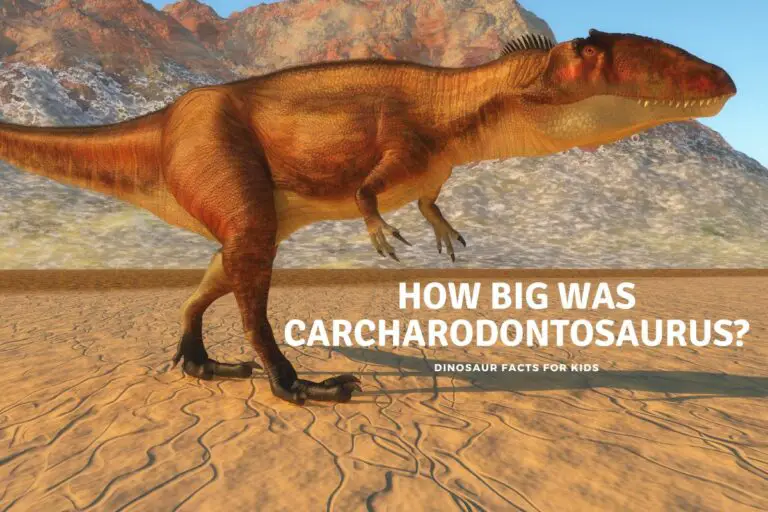How Big Was a Carnotaurus?
Carnotaurus was an awesome and unusual dinosaur that lived during the Late Cretaceous period, around 70 million years ago. It part of the theropod family, which also includes famous predators like T-Rex and Velociraptor. Carnotaurus had a unique look that set it apart from its dino relatives. It had a flat snout and horns above its eyes. It looked a little fierce bull mixed with a T-Rex! and its name actually means meat eating bull. We take a look at how large a dinosaur it was here.
Carnotaurus was a medium-sized theropod dinosaur, measuring up to 8-9 meters in length, 3 meters in height, and weighing approximately 1-2 tons. Its unique skeletal features, such as its short arms, long tail, and horned skull, suggest that it was a fast and agile predator, specialized for hunting smaller prey.
But, let’s get to the point of this article. Just how big was Carnotaurus? We know that it was a meat-eating predator, so it needed to be pretty big to take down its prey. But, how big exactly? We take a look at its size, why it would be this large, and some comparisons with other dinosaurs in the article below.

What Was The Carnotaurus?
Carnotaurus was a formidable predator that roamed the earth during the Late Cretaceous period, roughly 70-80 million years ago in the then jungles of South America. it is recognised by the horns on its head and it’s almost comically short arms. Which you can check out in the video below.
Despite being a relatively recently dinosaur compared to its more famous cousins like T-Rex, There have incredibly detailed fossil of Carnotaurus, the only one actually, found, some of which even still have imprints of the scaled skin ( though no feathers)
We have a longer carnotaurus fact article here on the site, but we have listed some below for quick reference.
- Habitat: Carnotaurus lived in what is now South America, specifically in what is now Argentina, during the Late Cretaceous period.
- Time Period: It existed approximately 70-72 million years ago, towards the end of the Cretaceous period.
- Discovery: The first fossils of Carnotaurus were discovered in 1984 in the La Colonia Formation in Patagonia, Argentina, by a team of paleontologists led by José F. Bonaparte.
How Big was a Carnotaurus
To estimate the size of Carnotaurus, scientists and palaeontologists have and continue to use a variety of methods, including measurements of the fossils that have been discovered, comparisons with other dinosaurs, and computer simulations. We take a look at these in a section below.
According to these estimates and they can vary quite a lot especially in terms of the weight of a Carnotaurus.
However, Carnotaurus was likely between 7 to just over 8 meters long, (about 24-26 feet) about 3 meters tall at the hips, and weighed around 1300 to 2000 kg or 3-4500 lbs. This makes it roughly the same size as the well-known predator Allosaurus, although with a more streamlined body and of course those two bull like horns on its head.
Table 1: Size of Carnotaurus
| Dinosaur | Length | Height at Hips | Weight | When it Lived (mya) |
|---|---|---|---|---|
| Carnotaurus | 7-8 meters 24-26 feet | 2.5 – 3 meters 8 -10 feet | 1,350 2,000 kg 3-4.500 lbs | 71-69 mya |
In terms of its, sometimes unique, physical characteristics, Carnotaurus was known for its unique features, including its flat snout, horns above its eyes, teeny tiny arms and long, muscular legs.
These adaptations, well except for the arms, suggest that it was a fast and agile predator that relied on speed, you can see the quote from Wikipedia below, and maneuverability to catch its prey, rather than brute strength.
Scientists calculate that Carnotaurus had a top speed of up to 48–56 km (30–35 mi) per hour.
Wikipedia
Comparison of Carnotaurus to the Size of other Dinosaurs
Comparing Carnotaurus to other dinosaurs, especially the larger predators, we can see that it was roughly the same size as Allosaurus, another famous predator that lived a little earlier during the Late Jurassic period in what is now North America,
However, Allosaurus had a more robust body and shorter legs, which suggests that it relied more on strength and power than speed and agility. In contrast, Carnotaurus had a more streamlined body and longer legs, which would have allowed it to move quickly and with more precision and at some speed as you can see from the Wiki quote above.
it terms of size we have included the table below to give you some idea of how the carnotaurus stacks up next to other large predatory dinosaurs like the T-Rex, Baryonyx, and Giganotosaurus – which was from a similar location although 30 million years before.
Table 2: Comparison of Carnotaurus to Other Dinosaurs
| Dinosaur | Length (m) | Height at Hips (m) | Weight | When it Lived (mya) |
|---|---|---|---|---|
| Carnotaurus | 7-8 meters | 2.5 – 3 meters | 1,350 2,000 kg | 71-69 mya |
| T-Rex | 12.3-12.8 | 4 meters | 8-9000 kg | 68-66 mya |
| Allosaurus | 8-12 | 3.5-4.3 meters | up to 3,000 kg | 155-145 mya |
| Baryonyx | 7.5-10 | 2.5-3 meters | 1-1,700 kg | 130-125 mya |
| Giganotosaurus | 12-13.2 | 4-4.5 meters | 6.2-8,000 kg | 99-97 mya |
These estimates are based on fossil evidence, and that the exact size and weight of these dinosaurs would have varied depending on factors like age, sex, and individual variation. New discoveries and research may lead to updates and revisions of these estimates in the future.
Anatomy of a Carnotaurus
Carnotaurus had a fairly unique body type and anatomy that would have had significant implications for its size, weight, and other physical characteristics. For example, its deep, narrow skull would have made it shorter and more robust than many other theropod dinosaurs, which may have affected its overall size and weight.
The dinosaur’s small forelimbs were much shorter and less muscular than its hind limbs, which likely would have affected its weight distribution and overall body balance. In fact it is not sure if the forearms of the carnotaurus were actually vestigial ( unused) or served another purpose.
This means Carnotaurus may have been more reliant on its powerful hind legs to run and hunt prey, rather than on its forelimbs for grabing and cutting once it caught them.
Similarly, the long, slender hind limbs and three-toed feet of Carnotaurus would have been well-suited for running, which likely made the dinosaur a fast and agile predator.
It was relatively small in size compared to other large famous theropods like T. rex and Giganotosaurus which suggests that it was probably a more specialized hunter, relying on speed and agility rather than brute strength to catch its prey.
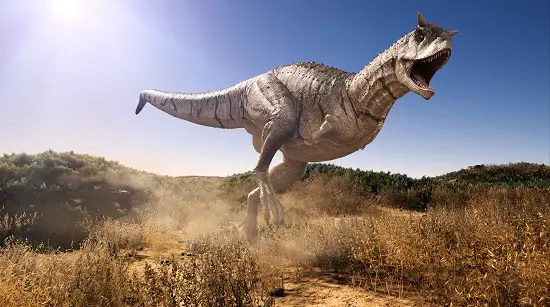
How Do We Know How Big Carnotaurus Was?
We know the size of Carnotaurus thanks to the discovery of a well preserved specimen including a nearly complete skeleton and skull even with imprints of the skin. By studying these fossils, paleontologists can estimate the size and weight of the dinosaur, as well as other physical characteristics such as its height and length.
Bone Measurements
One of the key ways that scientists determine the size of a dinosaur is by analyzing its bones. By comparing the size and shape of different bones to those of other known dinosaurs, researchers can estimate the overall body size of the animal.
In the case of Carnotaurus, its size is also helped by the fact that its fossils were found intact and well-preserved, which allows for more accurate measurements.
3d Modeling.
In addition to studying its bones, researchers can also use computer modeling to create digital reconstructions of the dinosaur’s body and musculature. This can help to estimate the size and shape of soft tissue structures such as muscles, tendons, and ligaments, which can in turn provide a more accurate picture of the animal’s overall size its bulk, and its weight.
Conclusion
Carnotaurus was a unique and fascinating dinosaur that stood out among its theropod relatives due to its distinctive body type and anatomy.
At around 24 to 26 feet in length and around 3 to 4,000 lbs in weight it was certainly no small dinosaur, but it was still considerably smaller than the large carnivores like Tyrannosaurus and Giganotosaurus. However it was likely to have been quicker and more nimble than both ( possibly even put together)
It likely used this speed to run down its prey, rather than ambush and it would certainly have been a terrifying sight to see it bearing down, even with those teeny tiny arms!
References
- https://www.sixflags.com/newengland/events/dinosaur-walk-thru/carnotaurus#:~:text=Carnotaurus
- https://www.jurassicworld3.net/topic/36568
- https://www.dinopit.com/just-how-big-was-carnotaurus/
Hi, I am Roy Ford a General Studies and English Teacher who has taught all over the world. What started as a fossil collection became a great way to teach, motivate and inspire students of all ages and all over the world about dinosaurs and from that and children’s love of dinosaurs came the site dinosaur facts for kids, a resource for all ages.


